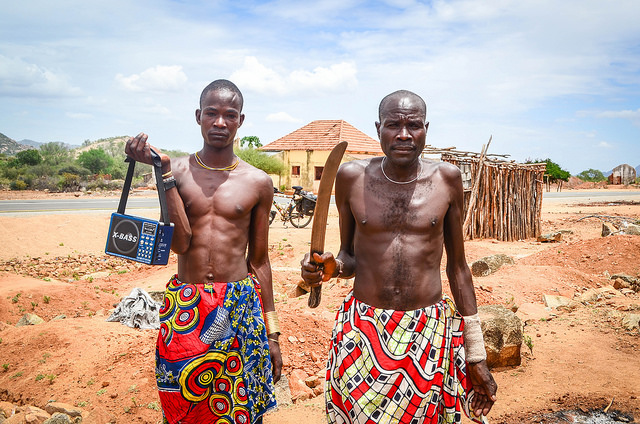
Two native Angolan men in traditional wear - Image courtesy jbdodane
Angola is a geographically having large territories and it is located in the Southern Africa bordered by Namibia on the south, the Democratic Republic of the Congo on the north, and Zambia on the east; its west coast is on the Atlantic Ocean and Luanda is its capital city. Angola is a member state of the African Union, the Community of Portuguese Language Countries, the Latin Union and the Southern African Development Community. Angola remained a Portuguese colony in the nineteenth century and after becoming independent state 1975; Angola was the scene of an intense civil war from 1975 to 2002. Angola is officially known as the Republic of Angola.

Angola is a country of having many ethnic communities. The Ovimnumdu population mainly dwells in the central regions of the country and they are the largest ethnic group in Angola. Likewise, the Mbundu people live around Luanda province and the Bakongo people live around the northwest provinces. Other large groups include the Nganguela and the Lunda-Chockwe. The majority of the population is either following Christianity (Roman Catholic) or follows native beliefs.

Like other South African countries, the Angolans have adapted the Western style of clothing today and in the urban areas, the Angolans are generally seen wearing jeans and T-shirts. The traditional dress of Angola is the symbol of the ethnic culture of Angola as they have continued to follow their own cultural traits, traditions and languages. Mainly influenced with the cultural influences of typical Africa, the traditional dress of Angola is also having varying designs and patterns and made with various textiles.

The traditional Angolan costumes are made with hand-woven cotton clothes while some ethnic people wear the clothes made with animal skins. It is pertinent to mention that during the colonization, the European missionaries and specially the Portuguese colonial regulations strongly discouraged or even tried to ban completely the traditional way of clothing in Angola. But even then the Angolans feel immense pride in their traditional appearances.

Body adornment is a significant part of the typical Angolan culture. In the festive events or ritual ceremonies the Angolan men wear tattoos expressing their prestige and status. The Angolan men usually appear in the body costumes from shoulder down made with vegetable fabric or beaten bark. The mask is made with designed wood or resin.

The Angolan women specially pay attention to their makeup and personal adornments. Their hairstyles might include weaving or braiding hanging to their shoulders. Their jewelry is important as they love to wear bracelets, necklaces and other bead ornaments for their embellishment. The women also decorate themselves with different types of aprons and loincloths usually mad with woven vegetable fiber. The typical block-patterned African fabrics, wrapped around the body in artful ways in the tribal women of Angola can be often seen.
